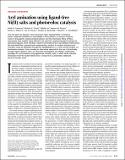Aryl amination using ligand-free Ni(II) salts and photoredox catalysis
Author(s)
Corcoran, Emily B.; Lin, Shishi; Dreher, Spencer D.; DiRocco, Daniel A.; Davies, Ian W.; MacMillan, David W. C.; Pirnot, Michael T; Buchwald, Stephen Leffler; ... Show more Show less
DownloadPrimary article (1.281Mb)
OPEN_ACCESS_POLICY
Open Access Policy
Creative Commons Attribution-Noncommercial-Share Alike
Terms of use
Metadata
Show full item recordAbstract
Over the past two decades, there have been major developments in transition metal-catalyzed aminations of aryl halides to form anilines, a common structure found in drug agents, natural product isolates, and fine chemicals. Many of these approaches have enabled highly efficient and selective coupling through the design of specialized ligands, which facilitate reductive elimination from a destabilized metal center. We postulated that a general and complementary method for carbon-nitrogen bond formation could be developed through the destabilization of a metal amido complex via photoredox catalysis, thus providing an alternative approach to the use of structurally complex ligand systems. Here, we report the development of a distinct mechanistic paradigm for aryl amination using ligand-free nickel(II) salts, in which facile reductive elimination from the nickel metal center is induced via a photoredox-catalyzed electron-transfer event.
Date issued
2016-07Department
Massachusetts Institute of Technology. Department of ChemistryJournal
Science
Publisher
American Association for the Advancement of Science (AAAS)
Citation
Corcoran, Emily B. et al. “Aryl Amination Using Ligand-Free Ni(II) Salts and Photoredox Catalysis.” Science 353, 6296 (June 2016): 279–283 © 2016 American Association for the Advancement of Science
Version: Author's final manuscript
ISSN
0036-8075
1095-9203